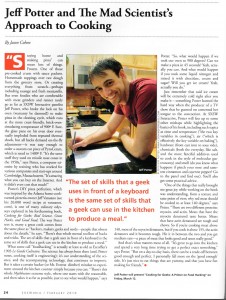I had nothing to do with the title, but it makes me laugh. Article by Jason Cohen ; reprinted from SXSWorld with permission. -J
 “Staying home and making pizza” can mean lots of things. Frozen. One of those pre-cooked crusts with sauce packets. Homemade toppings over raw dough from the grocery store. Or creating everything from scratch—perhaps including sausage and fresh mozzarella. But even foodies who are comfortable with meat grinders and rennet rarely go as far as SXSW Interactive panelist Jeff Potter, who broke the lock on his oven (warranty be damned!) to make pizza in the cleaning cycle, which runs at the more crust-friendly, brick-oven-simulating temperature of 900°F. Sure, the glass pane on his over door eventually imploded from repeated thermal shock, but all hacks demand on-the-fly adjustment—it was easy enough to order a custom cut piece of PyroCeram, which is rated to 1400°F. “It’s the same stuff they used on missile nose cones in the 1950s,” says Potter, a computer scientist by training who has worked for various companies and start-ups around Cambridge, Massachusetts. “It’s amazing what you can buy on the Internet. And it didn’t even cost that much!”
“Staying home and making pizza” can mean lots of things. Frozen. One of those pre-cooked crusts with sauce packets. Homemade toppings over raw dough from the grocery store. Or creating everything from scratch—perhaps including sausage and fresh mozzarella. But even foodies who are comfortable with meat grinders and rennet rarely go as far as SXSW Interactive panelist Jeff Potter, who broke the lock on his oven (warranty be damned!) to make pizza in the cleaning cycle, which runs at the more crust-friendly, brick-oven-simulating temperature of 900°F. Sure, the glass pane on his over door eventually imploded from repeated thermal shock, but all hacks demand on-the-fly adjustment—it was easy enough to order a custom cut piece of PyroCeram, which is rated to 1400°F. “It’s the same stuff they used on missile nose cones in the 1950s,” says Potter, a computer scientist by training who has worked for various companies and start-ups around Cambridge, Massachusetts. “It’s amazing what you can buy on the Internet. And it didn’t even cost that much!”
Potter’s DIY pizza perfection, which was inspired by the Atlanta home-cook-turned-pizzeria-owner Jeff Varasano (see his 20,000 word recipe at varasanos.com ), is one of many culinary odysseys explored in his forthcoming book, Cooking for Geeks, Real Science, Great Hacks, and Good Food . The way Potter sees it, many a great cook comes from the same place as “hackers, makers, geeks and nerds—people that obsess about the details, “ he says. “There’s that whole mental toolbox of hacks and tricks. The set of skills that a geek uses in front of the keyboard is the same set of skills that a geek can use in the kitchen to produce a meal.”
What some call “foodhacking” is actually at least as old as Escoffier’s 1903 Le Guide Culinare . The science has always been there (and, Potter notes, cooking itself is engineering); it’s our understanding of the science, and the accompanying technology, that continues to improve. But it takes a certain hacker (or Mt. Everest climber) mindset to experiment around the kitchen counter simply because you can. “There’s this whole Mythbusters extreme style, where one starts with reasonable, and then takes it as far as possible, just to see what would happen,” Potter. “So, what would happen if we took our oven to 900 degrees? Can we make a pizza in 45 seconds? Yeah, actually you can. And what would happen if you took some liquid nitrogen and mixed it with chocolate, cream and sugar? Will you get ice cream? Yeah, actually you do.”
Just remember that said ice cream will be extremely cold right after you make it – something Potter learned the hard way when the producer of a TV shot that he guested on cemented her tongue to the concoction. At SXSW Interactive, Potter will fess up to some other mishaps while highlighting the basics of his book, including such topics as time and temperature (“the two key variables in cooking”), air (“when is effectively the key variable on baking”), hardware (from cast iron to sous vide), chemicals (both the everyday, like salt, and the more fanciful additives used to cook in the style of molecular gastronomy) and smell (do you know what happens if you pink your nose and taste-test cinnamon and cayenne pepper? Go to the panel and find out.) You’ll also get some practical advice.
“One of the things that really brought me great joy while working on the book was understanding, from a texture and taste point of view, why red meat should be cooked to at least 140 degrees,” says Potter. “There are two different proteins: myosin, and actin. Meats that have the myosin denatured taste better. Meats that have actin denatured are tough and chewy. So if you’re cooking meat above 140, most of the myosin denatures, but if you cook it above 155, the actin denature and it becomes tough. Hit it in between the two and you get medium rare—a piece of meat that looks good and tastes really good.”
And that’s what matter most of all. “It’s great to go into the kitchen and spend a very long time trying to get a perfect exact something,” says Potter. “But on a day-to-day basis, there can be a trade-off between good enough and perfect. I personally fall more on the ‘good enough; side. It’s just nice to eat things that are yummy, and that you have fun making for friends.”